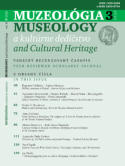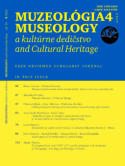

MUZEOLÓGIA
MUSEOLOGY
a kultúrne dedičstvo
and Cultural Heritage

News
Journal Muzeológia a
kultúrne dedičstvo -
Museology and Cultural
Heritage:
SJR 2024: 0,424 (Q1)
Museology SJR rank: 8/83 (Q1) Conservation SJR rank: 11/103 (Q1)JIF WoS 2023: 0,6
JCI WoS 2023: 1,28, Q1 ESCI: 49/411 (Q1)New issue
Muzeológia a kultúrne
dedičstvo 1/2025
online New volume Studia Museologica Slovaca, vol. 8 (2024) online New volume Populačné štúdie Slovenska 17 (2024) onlineNew book
P. Tišliar (ed.). Osobnosti uměleckoprůmyslového muzejnictví (2025). online
Contents 4/2022
Title: Museum transition toward market-oriented identity: between social issues and public policy
Abstract: The museum as a cultural institution was created as a part of the nation-state, according to nationalism ideology, and for the
transmission of the historical heritage of a particular society and culture. It resulted in organisational assumptions as rules of practices
and style of operations or management. The transformation of public management in cultural institutions, such as museums, is part of
the model of the “big” transformation based on the neoliberal turnaround in thinking and acting in the late twentieth century. The paper
constitutes an analysis of the mechanisms of contemporary public policies of cultural institutions. It examines the role of the museum
at the market-oriented levels of analysis as production, exchange and consumption. This study is based on desk research analysis
and argues that a new identity of the museum has appeared that is still shifting towards a new direction created by the SARS-COVID-
19 pandemic.
Authors: Geisler, Robert; Nieroba, Elżbieta
Publication order reference: University of Opole, Institute of Political Science and Administration, Poland, e-mail:
rgeisler@uni.opole.pl, ORCID: https://orcid.org/0000-0002-0218-980X; University of Opole,
The Faculty of Social Sciences, Department of Sociology, Poland, e-mail: enieroba@uni.opole.pl, ORCID: https://orcid.org/0000-0002-
7622-8701
Source: Muzeológia a kultúrne dedičstvo, year: 2022, vol.: 10, number: 4, pages: 5-25.
Key words: museum, management, museum identity, public policy
Language: English
online full-text PDF
DOI: 10.46284/mkd.2022.10.4.1
Title: Migration Museums: A Proposed Typology
Abstract: The aim of this article is to propose the perception of migration museums as a coherent group. Migration museums are
perceived by some professionals as specialised, thematic historical or ethnographic museums, whereas this paper organises the
diversity of historical and contemporary migratory movements in connection with the current dynamic development of museums.
Among the migration museums, the following types were grouped and distinguished: migration museums which comprehensively
address the subject of various migrations, migration museums in the historical migration infrastructure, open-air migration museums,
migration museums dedicated to specific events, migration museums established by immigrant communities and virtual migration
museums. The importance of addressing the topic of migration in other types of museums, such as maritime, ethnographic, historical
and art museums, is also highlighted. Covering the global network of migration museums allows us to search for answers to the
question of the role of museums at a time when refugees and climate migrations will be among the greatest challenges for humanity.
Author: Petelska, Michalina
Publication order reference: University of Gdańsk, Faculty of History, ul. Wita Stwosza 55, 80-308 Gdańsk, Poland, e-mail:
michalina.petelska@ug.edu.pl, ORCID: https://orcid.org/0000-0002-7436-3280
Source: Muzeológia a kultúrne dedičstvo, year: 2022, vol.: 10, number: 4, pages: 27-45.
Keywords: migration, typology of museums, migration infrastructure, migration museums
Language: English
online full-text PDF
DOI: 10.46284/mkd.2022.10.4.2
Title: Clothing displayed in museums: from conservation to innovative design representations
Abstract: The presentation in museum exhibitions of samples of historical clothing, fashionable costumes from different periods and
conceptual costumes of our time has acquired particular relevance. The development of exhibition design has attracted the attention of
gallery owners, curators and representatives of the scientific community. The general cultural significance of the practices of
preserving the heritage of material and artistic cultures and their representations synthesises traditional and innovative approaches to
reconstruction, conservation and perception of costume, while remaining poorly studied. The strategies of contemporary curatorial
practices form alternative approaches to fashion exhibitions and their organisation. In the information society, fashion exhibitions have
become self-sufficient art projects that require careful scientific consideration.
Authors: Lahoda, Oksana; Alferova, Zoya; Hurdina, Vladyslava
Publication order reference: Kharkiv State Academy of Design and Arts, Department of Fabric and Clothing Design, Ukraine
e-mail: oxanalahoda@gmail.com, ORCID: https://orcid.org/0000-0003-1808-7119; Kharkiv State Academy of Design and Arts,
Department of Fabric and Clothing Design, Ukraine, e-mail: al055@ukr.net, ORCID: https://orcid.org/0000-0003-4698-9785;
Kharkiv State Academy of Design and Arts, Department of Fabric and Clothing Design, Ukraine, e-mail: vlada.gurdina@gmail.com,
ORCID: https://orcid.org/0000-0002-9040-3676
Source: Muzeológia a kultúrne dedičstvo, year: 2022, vol.: 10, number: 4, pages: 47-62.
Keywords: costume, design of expositions, museum space, representation
Language: English
online full-text PDF
DOI: 10.46284/mkd.2022.10.4.3
Title: Adaptation of places of worship to secular functions with the use of narrative method as a tool
to preserve religious heritage
Abstract: Sacral objects are an important part of Europe’s religious heritage. For centuries, temples have constituted a key element in
the urban morphology; they fit into the urban fabric of European cities and are permanently embedded there. Due to the current
laicization of Europe, the adaptation of sacred buildings into secular functions has become a necessity for economic reasons. Their
owners, architects, conservators and historians are faced with a dilemma: whether to preserve an object or transform it into another
function? Places of worship cannot be considered in solely economic terms due to the identity of the place, its current function and its
symbolism. Sacred spaces, apart from their function, structure and form, also have meaning. In holy sites, the symbol becomes a
narrative tool. The purpose of a narrative in the cultural context is related to the site, the narrator, the recipient and the time of the
narrative. Narrative research into semantic architecture, as one of the means of researching sacred architecture, has potential both in
analysis and as a tool to facilitate design processes for the appropriate transformation of sacred buildings to serve secular functions.
Authors: Wierzbicka, Anna Maria; Arno, Maria
Publication order reference: Warsaw University of Technology, Department of Fundamentals of Architectural and Urban Design, 00-
659 Warsaw, Poland, e-mail: anna.wierzbicka@pw.edu.pl, Orcid ID: https://orcid.org/0000-0003-4548-6844; Warsaw University of
Technology, Department of Fundamentals of Architectural and Urban Design, 00-659 Warsaw, Poland, e-mail:
maria.arno.dokt@pw.edu.pl, Orcid ID: https://orcid.org/0000-0001-6794-2578
Source: Muzeológia a kultúrne dedičstvo, year: 2022, vol.: 10, number: 4, pages: 63-77.
Keywords: adaptation; sacral buildings; semantic architecture; narrative research
Language: English
online full-text PDF
DOI: 10.46284/mkd.2021.10.4.5
Title: Particularities of wooden carved iconostases in selected post-Byzantine churches of Albania
Abstract: This paper presents the data and study results of the post-Byzantine wood carved iconostases of different churches in
Albania, which notwithstanding the circumstances of the communistic period have preserved to a considerable extent their typical
characteristics. The paper aims to examine the stylistic and morphological aspects of the iconostasis in selected churches in relation
to the architecture and tries to identify the relationships, sequences and reasons for such phenomena.
The presence of iconostases in the Eastern Orthodox Church is based on the carried rituals and services that are expressed through
ecclesiastical sculptures and other works. In these contexts, the iconostasis is the most dominating screen, related to the rood screen
of English mediaeval churches, but contrary to them it is a closed and solid structure. In the iconostasis, architecture and wood carving
workers collaborate on a large scale in order to create a solid and well-integrated frame. The analysis includes St Mary’s Monastery,
also known as the Monastery of Dormition of Theotokos Mary, a medieval Byzantine church on Zvërnec island in the Narta Lagoon,
southwest of the city of Vlora, southwestern Albania (SMZ); the Church of Apostles in Hoshtevë, Gjirokastra, with its spectacular
interior completely covered with frescoes that became a cultural monument of Albania in 1948 (SA); and the Church of the Dormition
of the Theotokos, simply known as Koimissi or St Mary, in the village of Labovë e Kryqit, Gjirokastër County, southern Albania (SM).
Author: Shumka, Laura
Publication order reference: Albanian University, Tirana, Department of Art & Design, Albania, e-mail: shumkalaura@gmail.com,
ORCID: https://orcid.org/0000-0003-1341-4627
Source: Muzeológia a kultúrne dedičstvo, year: 2022, vol.: 10, number: 4, pages: 79-88.
Keywords: cultural heritage, post-Byzantine, churches, Albanian, iconostasis
Language: English
online full-text PDF
DOI: 10.46284/mkd.2022.10.4.6
Title: Spatial aspects of the interpretation of cultural heritage
Abstract: Creating an exhibition is a multidisciplinary task which, besides the work of the authors of the scenario, copywriters and
experts in the given topic, involves also the work of architects and landscape architects. Although the paper reflects on various
completed exhibitions, the scenario and form of an exhibition cannot be separated. The paper focuses on spatial aspects of outdoor
exhibitions from the perspective of an architect and landscape architect and documents them via various completed exhibitions. In
terms of architecture they can be classified upon the aspects of form and content, wherein form covers the spatial, i.e. architectural,
design of the exhibition and means, and content covers the quantity, complexity, style and chronology of the information
communicated. The motivation for the paper is the need to identify the factors influencing the educational quality of exhibitions that the
professionals designing the space and form of exhibitions may use in their practice. This covers predominantly those factors that relate
to the designing of spaces where exhibitions take place based on the given scenarios, to which the viewers react rather
subconsciously.
The method used for the research is a spatial and content analysis of three exhibitions presenting cultural and natural heritage,
specifically Hardangervidda National Park in Norway, Kongernes Jelling visitor centre in Denmark, and the National Museum of Rural
Life at Wester Kittochside – Scottish National Museum in Great Britain. Factors considered include: the connection to the site –
landscape context; authenticity; spatial scenario; and so-called warm-up and cool-down spaces that create atmosphere. A scenario, as
in a film, connects the environment and content in a defined chronology. By this research we want to follow up on the trend in
museums and exhibitions to present information through powerful narrative storytelling.
Authors: Sedlacek, Jozef; Matějka, Daniel; Fialová, Zuzana; Klepárník, Radim
Publication order reference: Mendel University in Brno, Department of Landscape Planning, Valtická 337, 69144 Lednice, Czechia
e-mail: jozef.sedlacek@mendelu.cz, ORCID: https://orcid.org/0000-0001-7470-0593; Mendel University in Brno, Department of
Landscape Planning, Valtická 337, 69144 Lednice, Czechia, e-mail: daniel.matejka@seznam.cz, ORCID: https://orcid.org/0000-0002-
6737-3229; Mendel University in Brno, Department of Landscape Planning, Valtická 337, 69144 Lednice, Czechia,
e-mail: kontakt@zuzanafialova.cz, ORCID: https://orcid.org/0000-0003-2395-9153; Mendel University in Brno, Department of
Landscape Planning, Valtická 337, 69144 Lednice, Czechia, e-mail: r.kle@seznam.cz, ORCID: https://orcid.org/0000-0001-9481-2162
Source: Muzeológia a kultúrne dedičstvo, year: 2022, vol.: 10, number: 4, pages: 89-113.
Keywords: architecture, landscape architecture, heritage, interpretation, visitor centre
Language: English
online full-text PDF
DOI: 10.46284/mkd.2021.10.4.6
Title: The forgotten Karol Andel (1897–1977) and his contribution to the development of Ethnography,
Archaeology and Museology in Slovakia
Abstract: The paper is an evaluation study of the biographical work of Karol Andel, who, as a civil servant in the interwar and post-war
periods, devoted himself to the amateur collection of ethnographic material and the search for archaeological sites. His work refuted
opinions of the prehistoric sterility of many regions, and also laid the foundations of many ethnographic and archaeological collections
in Slovakia – in Kysuce Záhorie, Levoča and Bojnice, and at the Slovak National Museum in Bratislava. In his fieldwork he
collaborated with respected authorities of archaeology and ethnography in Slovakia, including J. Eisner, V. Budinský-Krička, Š.
Janšák, B. Szöke, R. Bednárik and M. Markuš. Thanks to his lifelong professional work and passion, he eventually became a
researcher at the Ethnographic Institute, and later the Archaeological Institute of the Slovak Academy of Sciences.
Author: Priečko, Martin
Publication order reference: University of Ss Cyril and Methodius in Trnava, Department of Ethnology and World Studies, Slovakia
e-mail: martin.priecko@ucm.sk, ORCID: https://orcid.org/0000-0002-0963-7660
Source: Muzeológia a kultúrne dedičstvo, year: 2022, vol.: 10, number: 4, pages: 115-131.
Keywords: Karol Andel, Ethnographer, Archaeologist, amateur collector, development of museology in Slovakia, interwar period
Language: English
online full-text PDF
DOI: 10.46284/mkd.2021.10.4.7
Articles (Abstracts)

Full-text version
DOI:10.46284/mkd.2022.10.4.0
ISSN 1339-2204
eISSN 2453-9759
EV 1/22/EPP
Vol. 10 (2022), No. Is. 4



























